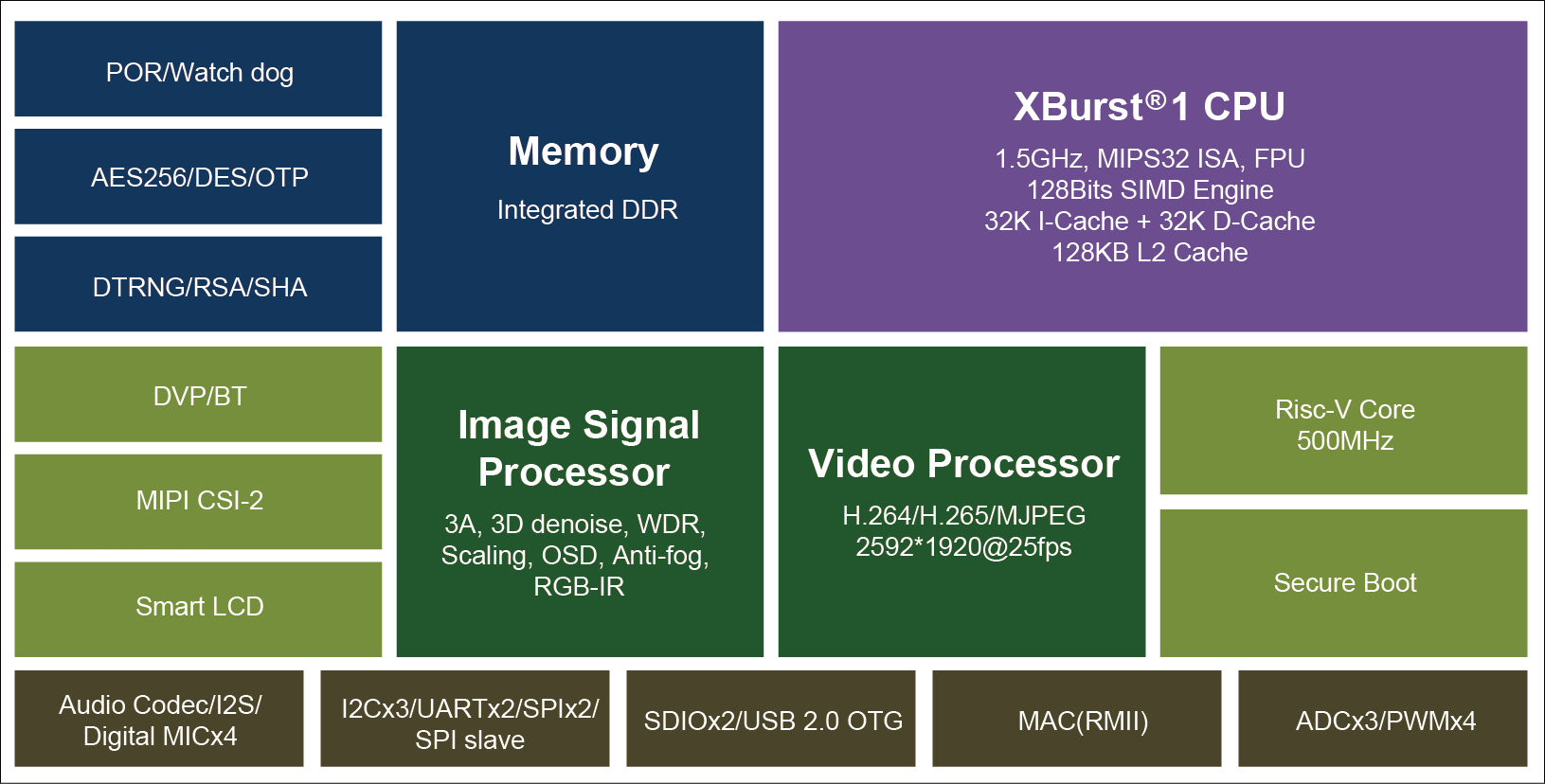Last week we asked “is MIPS dead?” question following the news that Wave Computing had filed for bankruptcy, two MIPS Linux maintainers had left, and China-based CIP United now obtained the exclusive MIPS license rights for mainland China, Hong Kong, and Macau.
Ingenic is one of those Chinese companies that have offered MIPS-based processors for several years, but one commenter noted that Ingenic joined the RISC-V foundation, and as a result, we could speculate the company might soon launch RISC-V processors, potentially replacing their MIPS offerings.

But Ingenic T31 video processor just features both with a traditional Xburst MIPS Core combines with a RISC-V “Lite” core
Ingenic T31 specifications:
- Processors
- XBurst 1 32-bit MIPS core clocked at 1.5GHz with Vector Deep Learning accelerator based on SIMD128, 64KB + 128KB L1/L2 Cache
- RISC-V independent lite core
- System Memory – Built-in 512Mbit (64MB) or 1Gbit (128MB) DDR2
- Storage – Quad SPI flash, NAND flash, SD card I/F
- Display I/F – Supports Smart LCD (SLCD) Display
- Video Encoder – H.264/H.265/MJPEG up to 2592×1920 @ 30fps with multiple streams support
- Camera
- MIPI CSI-2 & DVP/BT interfaces
- Supports 5M @ 30fps
- Starlight ISP
- Optimizations for low light and surveillance scenarios
- Upgraded 2D / 3D noise reduction
- Sharpening enhancement, ROI-AE, advanced WDR, DRC, distortion correction
- Audio – integrated audio codec up to 96Kbps, I2S, 4-channel digital MIC array; echo cancellation
- Networking – GMAC (from specs), RMII (from block diagram)
- USB – 1x USB OTG Interface
- Other Peripherals – WDT, 3x ADC, 2x UART, 3x I2C, 2x SPI, GPIO, 2x SDIO, 4x PWM
- Security – AES/RSA/SHA/TRNG/OTP; secure boot
- Power Consumption – Minimum: 300 mW (I suppose in idle mode, not deep sleep); typ.: 500mW including DDR (1080p @ 25fps H.265)
- Package – QFN88, BGA 9x9mm
- Process – 22nm
The processor supports fast boot with 200ms stable video output including fast AE (Auto Exposure) / AWB (Auto White Balance) and can be interfaced with WiFi and Bluetooth module.
Ingenic T31 is compatible with USB UVC and UAC and as such, is designed to be integrated into standardized video or audio products. Built-in AI algorithms enable human detection, facial detection/recognition, cry detection, vehicle detection, pets detection.
As I understand it, the MIPS core runs Linux, while the RISC-V core runs an unnamed RTOS. Based on the specifications including the highlight of fast boot capabilities, I’d assume this video processor targets surveillance cameras that wake up when motion is detected. This probably means the RISC-V processor is optimized for low power consumption and handles PIR detection, and after wake up the MIPS processor takes over to process the video and audio signals with the help of the ISP and video encoder, and run AI algorithms as needed.
More details may be found on the product page and Indasina website.
Thanks to Alex for the tip.

Jean-Luc started CNX Software in 2010 as a part-time endeavor, before quitting his job as a software engineering manager, and starting to write daily news, and reviews full time later in 2011.
Support CNX Software! Donate via cryptocurrencies, become a Patron on Patreon, or purchase goods on Amazon or Aliexpress





Considering there is almost no one working on MIPS upstream I can’t imagine the SDK/BSP for these things being all that good.
These chips are quite cheap and they have a reasonable SDK. The “AI” support is minimal, it is just those SIMD128 instructions that have been added to the core. These chips are used in the Wyse cameras. The “AI” support is enough to do basic image recognition like human vs pet. If you follow the links on Ingenic website you can buy their development boards for around $200. Our problem with these chips is that the are meant for surveilence cameras only, there is no way to attach an LCD to them.
Edit: this new T31 may have added an LCD controller. We looked at the older T30/T20.
It’s can be very nice with display broadcast over h265 encoding, 500mW is effective but without great sdk nothing to hope
I don’t have a T31 datasheet, but their older JZ4740 also has the SLCD controller. Likely they reused the IP.
http://read.pudn.com/downloads225/ebook/1060629/Jz4740-spec/Jz4740_12_slcd_spec.pdf
It is normal RGB type LCD controller.
That SoC JZ4740 is popular with handheld retro consoles like the Anbernic RG-350. They claim to be open source emulation.
jz4740 was rather popular, but it’s 13 years old at this point. The peak of that product line as the dual-core jz4780 in 2012. As far as I can tell, there was a large amount of reuse in each further chip, but there were a lot of chips since then, and the the different product lines (JZxxxx, Xxxxx, T,xx Mxxx) have moved in different directions.
The JZ4740 was brought back to life last year because a lot of retro handhelds on china started using.
I dont know if they are using old supplies or still making then, but they are being used
This is all the datasheet says….
Layer feature
Support 2 layer DMA channel
Support input format: RGB8888/888/565/555,NV12/NV21
Support frame size 4×4~800×800
Support global alpha
Composition feature
Support 2 layer Alpha Blending
Support frame size 4×4~800×800
Display feature
Support TFT(RGB666)
Support SLCD
Support 640×480@60hz
There must be a standalone manual for SLCD like the one for the JZ4740